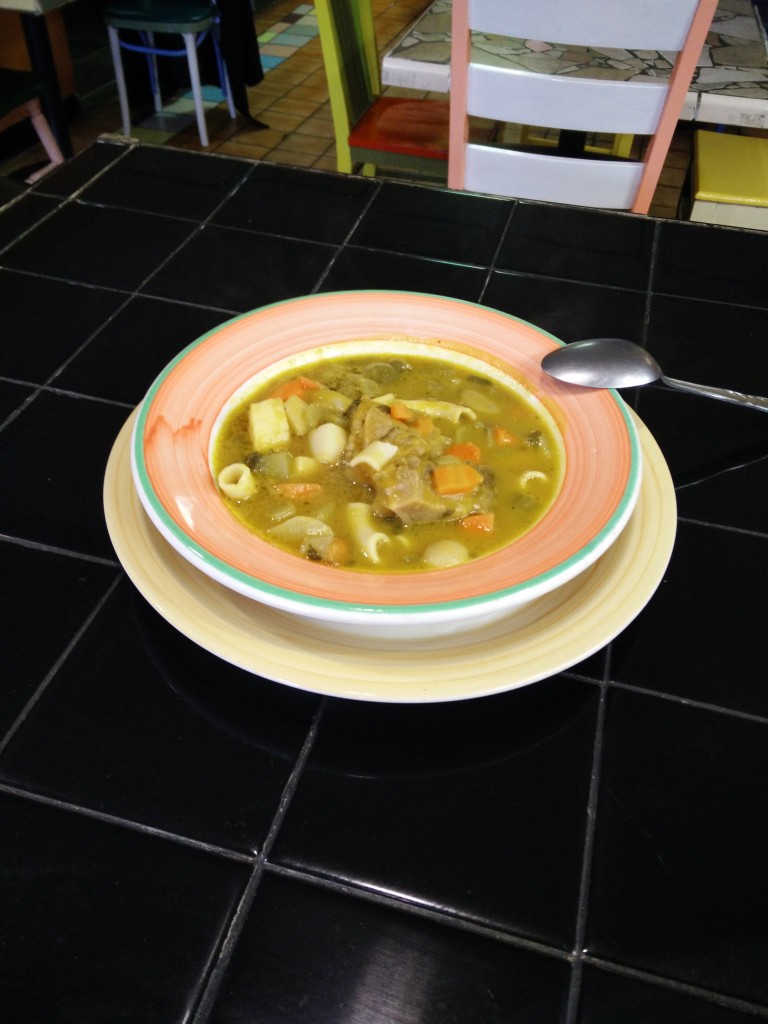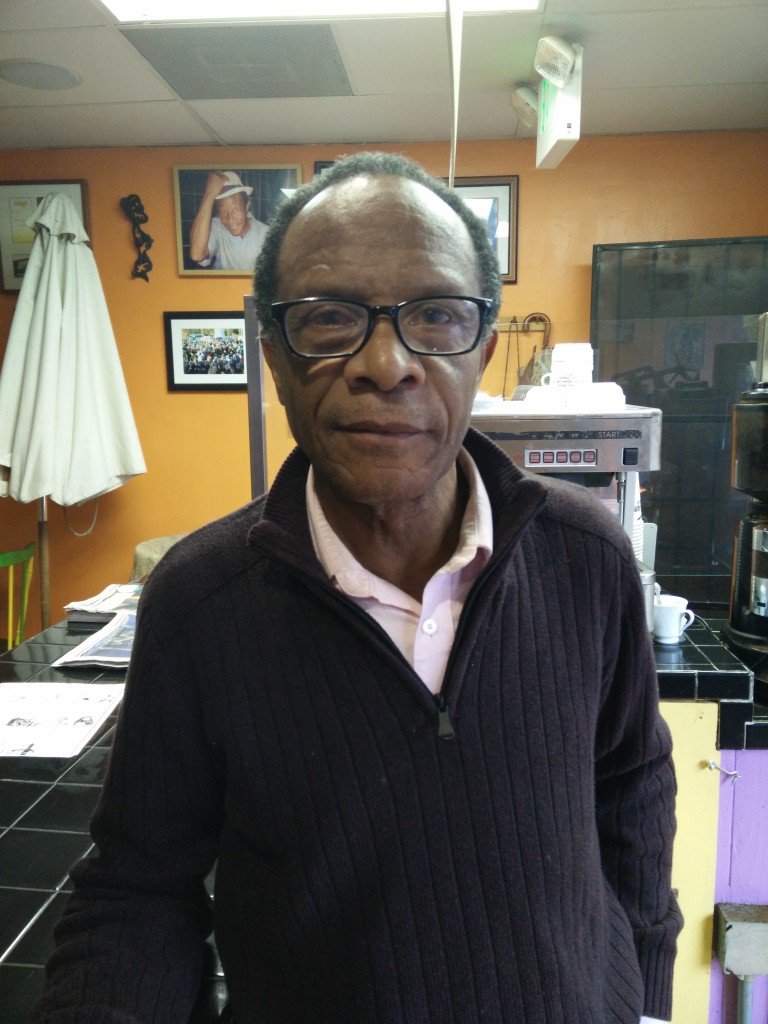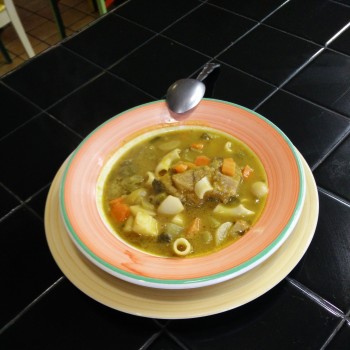Rico got a little ahead of himself this week and celebrated New Year’s Day. Except he sipped something without bubbles.
It’s called soup joumou — a soup with squash and macaroni that’s traditionally eaten on New Year’s Day in Haiti. To learn about it, Rico headed to the Haitian restaurant TiGeorges’ Chicken in L.A., where owner TiGeorges LaGuerre serves joumou once a week. Rico first asked TiGeorges to give him a quick overview of Haitian cuisine.

TiGeorges LaGuerre: Haitian, it’s almost like a fusion. You have the French culture incorporated with the African culture. Haiti, of course, was occupied by the Spaniards. Then the British. And that’s what brings the quality, the texture that you see in Haitian cuisine.
Rico Gagliano: Let’s talk about this soup, which is why we’re here. New Year’s soup.
TiGeorges LaGuerre: Soup joumou. A very meaningful thing for me, because my grandmother used to own a restaurant where she only served one item on the menu: squash soup. Only on Sunday. And it would take her the entire week to make that preparation.
She would boil the beef bone marrow like two to three days prior. In my case, my beef bone marrow been boiling for the last three or four hours.
Rico Gagliano: That’s the base — it’s like a bone marrow broth, I guess.
TiGeorges LaGuerre: That is correct. And then the squash.
Rico Gagliano: There is a great story behind this soup, is my understanding, as far as why it’s consumed on New Year’s in Haiti. Is that correct?
TiGeorges LaGuerre: Definitely. A great story. Because squash soup was forbidden to consume by the slaves.
Rico Gagliano: Only slave-owners could have it.
TiGeorges LaGuerre: A slave-owner, the master. Mainly they were French. So when Haiti became independent, to celebrate that, we wanted to show to the white master, “Now we are independent. So we are going to consume the squash soup.” And we choose January 1st to do that.
Rico Gagliano: So, there’s a lot of history wrapped up in this soup. Both personally and nationally for you. Let’s go…
TiGeorges LaGuerre: I’m going to show you, in my kitchen, how it’s being prepared. Then you will have to taste it before you leave today.
 Rico Gagliano: All right, so here we are in the kitchen. We’re in front of a stove. There is a huge steel pot of something delicious boiling, and some pans full of stuff. What’s happening?
Rico Gagliano: All right, so here we are in the kitchen. We’re in front of a stove. There is a huge steel pot of something delicious boiling, and some pans full of stuff. What’s happening?
TiGeorges LaGuerre: Well, what’s happening is there is the beef bone marrow. And that’s where you’re going to come across the flavor that you’re looking for.
Rico Gagliano: So, this has been boiling for hours, it looks like.
TiGeorges LaGuerre: Yeah, it’s been boiled for hours. So now, as you can see, we have boxes of squash.
Rico Gagliano: Yes, it’s just pre-prepared squash.
TiGeorges LaGuerre: Right. If I was in Haiti, I would probably go to the supermarket, to the open air market, and buy a real squash. It would be a more intense proposition to prepare that, OK?
Rico Gagliano: Cutting up squash is kind of a hassle?
TiGeorges LaGuerre: Right. Then you have to boil it, remove the seeds… it’s a challenge.
Rico Gagliano: God bless America! You can just open a box and there it is.
TiGeorges LaGuerre: Hey! You can say that loud! [Laughs.] Loudly, we could say that.
So, there you go. We’re going to add the squash. Now, to really make a squash soup, celery gives it the flavor. We put potato in there. We dice them. We put taro root…
Rico Gagliano: Taro root’s in there?
TiGeorges LaGuerre: Yes. And then parsley, carrots. Another thing with squash soup: key lime. It’s another essential ingredient.
Rico Gagliano: Oh, you’re going to put key lime in this?
TiGeorges LaGuerre: Key lime juice. The ingredient that goes in everything in Haitian recipes. And if I go to your house, I see you cooking, and I don’t see any key lime or sour oranges…
Rico Gagliano: Then I’m a fraud.
TiGeorges LaGuerre: …You’re not real! [Laughs.] You’re not legit!
Rico Gagliano: So we’ve watched this thing boil down. It’s now looking nice and rich and orange.
TiGeorges LaGuerre: Two more ingredients that we’re adding: that would be macaroni and cabbage.
Rico Gagliano: So, macaroni…
TiGeorges LaGuerre: So, you wonder where macaroni come from, right?
Rico Gagliano: I’m assuming this is a European influence.
TiGeorges LaGuerre: Definitely. Because these were the things… Remember, it was forbidden! It was something that the master could consume.
Rico Gagliano: I was going to say — because so far, this dish has a lot of vegetables, it has bones in it, nothing that I would think that somebody who was poor, for instance, wouldn’t be able to get. But [the macaroni] is the symbol of what they couldn’t have.
TiGeorges LaGuerre: That is correct.
[A bowl of joumou is put down in front of Rico]
Rico Gagliano: So we have here a beautiful dish of soup which has all the vegetables in the world in it. Here we go. I’m going to take a bite. [Rico tastes a spoonful of joumou.]
Oh, that’s delicious! Is there cilantro in this?
TiGeorges LaGuerre: Yes! I forgot cilantro!
Rico Gagliano: I love it. So, for me, I associate cilantro also with Latin America. There’s all sorts of continental influences happening with this. All different continents.
George Laguerre: Big time. Big time. Big time.
Rico Gagliano: And I’m not the only one here eating this. Garry Perard is here. He’s a friend of George’s. Garry, you’re going to demonstrate to me the traditional end of the soup meal.
Garry Perard: Yes. Traditionally, what’s done is: there’s usually a piece of bone in it, beef bone, and you suck out the marrow of the bone. The sauce that’s still in the marrow. It’s one of the critical things to do.
Even in the choicest restaurants that you might be in, you see people just digging in, sucking on bones. A lady of some stature sucking on a bone!

Rico Gagliano: But you don’t have any bone left in your bowl.
Garry Perard: Yeah. Well, we can also chew it [down] to where there is nothing! [He and TiGeorges laugh.]
Rico Gagliano: I notice George does have a bone left. So, you going to do the honors?
TiGeorges LaGuerre: Oh, yeah. You see it? [TiGeorges starts sucking the marrow out of the bone.]
Rico Gagliano: Classy!
TiGeorges LaGuerre: It’s a must. It’s classy.


